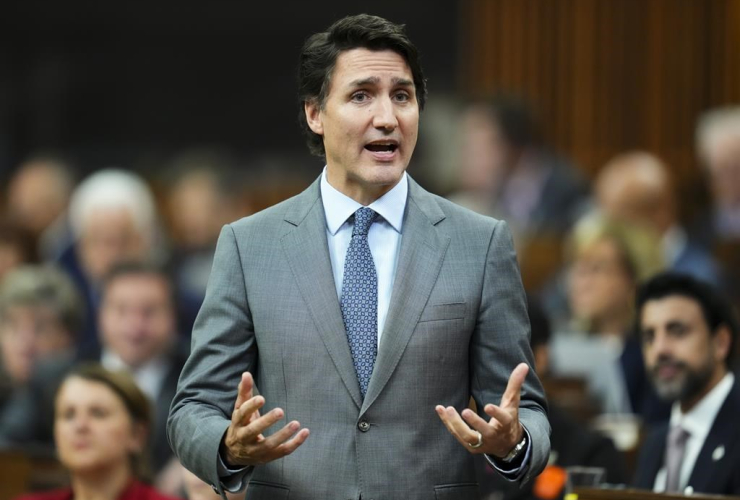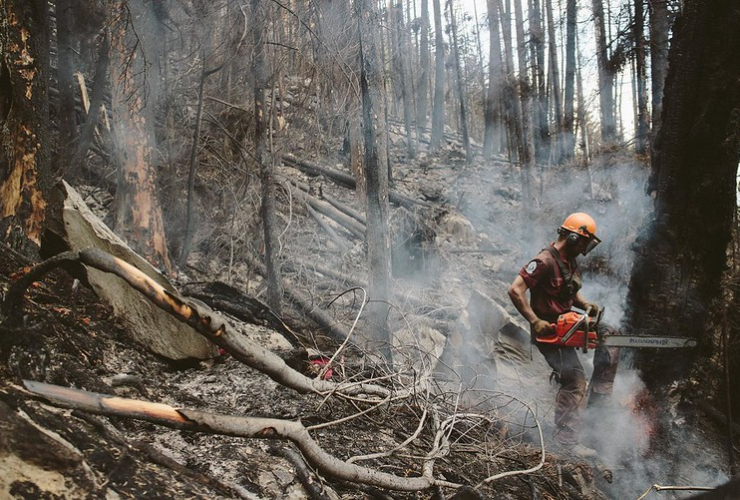Support journalism that lights the way through the climate crisis
As a sticky heat persisted over Toronto this week, Nate Erskine-Smith gathered outside Queen’s Park with a small crowd of climate leaders and Ontario Liberals to announce his climate plan, should he be elected to lead the party.
Erskine-Smith, the current MP for the Toronto riding of Beaches—East York, aims to fill Steven Del Duca’s shoes as leader of the Ontario Liberal Party. His climate platform includes an accelerated timeline for reducing greenhouse gas emissions, plans to designate 30 per cent of Ontario as protected land and a series of new positions aimed at tackling climate change. In its own latest estimate, Ontario stated about nine per cent of the province’s area is protected. Erskine-Smith said he would expand Ontario’s Greenbelt, creating provincial parks and protecting ravines like the ones that snake through the Greater Toronto Area.
Tim Gray, executive director of Environmental Defence, told Canada’s National Observer the plan is “comprehensive” and tackled most of Ontario’s climate issues.
“The components of this are solid,” Gray said. “It's well thought out, and I hope to see similar offerings from other (leadership) candidates.”
Standing by Erskine-Smith at the podium was former federal minister of environment and climate change Catherine McKenna. In a press release, McKenna said the province needs “ambitious climate leadership.”
“He has consistently shown strong leadership on climate,” McKenna said in the press release. “His ambitious climate plan is about building a cleaner, healthier Ontario that is a leader in the clean economy future.”
Erskine-Smith’s plan includes a goal to reduce planet-warming emissions to 50 per cent below 2005 levels by 2030. It matches the Ontario NDP’s and the Ontario Green Party’s 2022 election platforms and exceeds current Premier Doug Ford’s Made-In-Ontario plan to reach a 30 per cent reduction in emissions by the same deadline. Erskine-Smith also aims to hit net-zero emissions — meaning the province would reduce its emissions as much as possible and offset the remaining pollution — by 2040, five years sooner than the Green Party or NDP.
“We set out to deliver the most ambitious climate action and environmental protection plan in North America,” Erskine-Smith told Canada’s National Observer.
To reach a net-zero electricity grid, Erskine Smith said he will review Ontario’s moratorium on wind farming in the Great Lakes and support nuclear energy in the province.
“That would be fantastic for people looking to install solar or wind, either on a personal scale in their house or a larger scale on their properties,” Gray said.
But missing from Erksine-Smith’s plan, Gray said, was a commitment to end contracts to generate electricity using natural gas. Gray said he’d like to see an explicit signal to gas companies that the province intends to stop investing in gas-powered plants.
According to the Independent Electricity System Operator, the agency that manages Ontario’s grid, last year, 10.4 per cent of Ontario’s energy output came from oil- and gas-fired plants — up from four per cent in 2017, the year before Ford was elected premier. The Ford government has plans to build more gas-fired plants in the province, which would more than triple the emissions from the province’s grid.
Erskine-Smith’s plan calls for a “phaseout” of gas for electricity generation, except where it’s needed as a backup.
His plan also includes grants and loans for people looking to retrofit buildings to reduce emissions and investments in clean technology. He would mandate zero-emissions vehicle manufacturers to keep some vehicles for Ontarians and offer a rebate for Ontarians to purchase those vehicles new and used.
While Ontarians are eligible for the federal electric vehicle rebate, Ontario does not have its own, lagging behind British Columbia, Quebec and the Northwest Territories, among other jurisdictions.

Erskine-Smith also says he wants to make Ontario a centre for mining and refining critical minerals — elements needed to make batteries for electric vehicles and clean energy storage.
The federal critical minerals strategy notes extraction could increase emissions, pollute fresh water and threaten biodiversity in mining regions. Erskine said he would reduce those impacts by finding more efficient mining techniques and recycling critical minerals.
Included in Erskine-Smith’s critical minerals plan is a commitment to co-create standards for allowing mining, in accordance with standards in the United Nations Declaration on the Rights of Indigenous Peoples (UNDRIP).
Ontario does not currently recognize UNDRIP in provincial law. NDP MPP Sol Mamakwa introduced legislation to incorporate UNDRIP into Ontario law in March 2019. While the bill passed its second of three readings, it has been referred to Ontario’s Standing Committee on General Government for more than four years, and has not progressed into law.
British Columbia passed UNDRIP into provincial law in November 2019, and remains the only province to do so. This June, the federal government released an action plan to implement UNDRIP into federal law within five years.
“Doug Ford jumps on a bulldozer and says we're heading to the Ring of Fire, and completely undermines any collaborative conversations and partnerships with First Nations communities,” Erskine-Smith said. “We need to be building partnerships, relationships and delivering real economic reconciliation for Indigenous communities.”
Erskine-Smith also wants to create a provincial body to hold the government accountable to its emissions targets, like the federal net-zero advisory body.
“We need the same kind of a body and the same kind of independence and accountability here in Ontario,” Erskine-Smith said.
Erskine-Smith’s plan includes establishing a “Chief Heat Officer,” who he said would oversee heat emergencies and heat-reduction and cooling projects like implementing cooling centres and expanding tree canopy.
Gray said the plan would feasibly reduce emissions from Ontario and transition the province towards cleaner energy sources. While he had no idea whether the Ontario Liberals would support Erskine-Smith’s proposed climate platform, Gray said Canadians will increasingly vote based on climate change.
“People are literally dying as the result of climate change-induced disasters. I think the level of anxiety among the Canadian population is rapidly increasing,” Gray said. “There's going to be a point at which people turn to their elected officials and say, ‘What have you been doing?’”
The Ontario Liberals will vote on their next leader on Dec. 2.
This is good news. Of course,
This is good news. Of course, Nate Erskine-Smith would have to win the leadership of the Liberals in Ontario (or they would adopt his plan??) and then Ford would have to be defeated in the next election (June 2026 tentatively) before the plan could begin to be implemented. None the less, it does give Ontario residents some much needed hope on the climate front since Dougie has decided to shift it into reverse with plans to build three new gas powered plants on top of his willingness to shred the Greenbelt's status.
Good plan, but we need our
Good plan, but we need our current incompetent premier Doug Ford to lose the next election. Doug's "Climate Change No-Plan" is a joke and designed to continue with the status quo. Doug Ford, only here for his corrupt donors and no one else.
I have never been a Liberal
I have never been a Liberal party supporter, but I've followed Mr. Erskine-Smith's actions over the years.
This is the kind of leadership we desperately need in Ontario.
I will be supporting him in all ways in his leadership campaign, and hopefully, as the next Premier






Comments